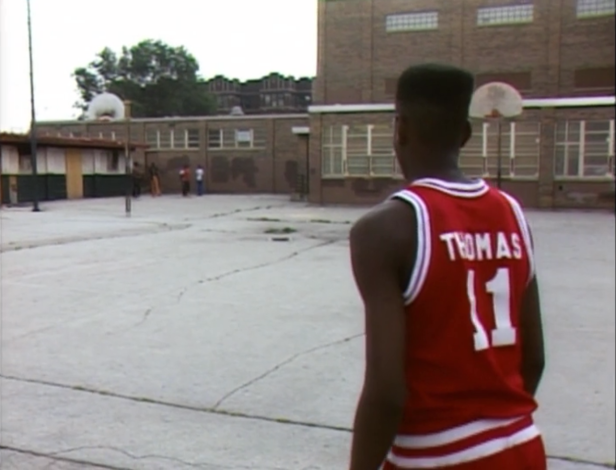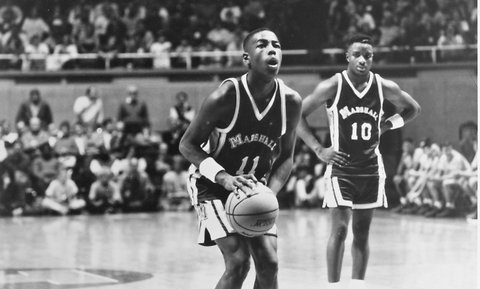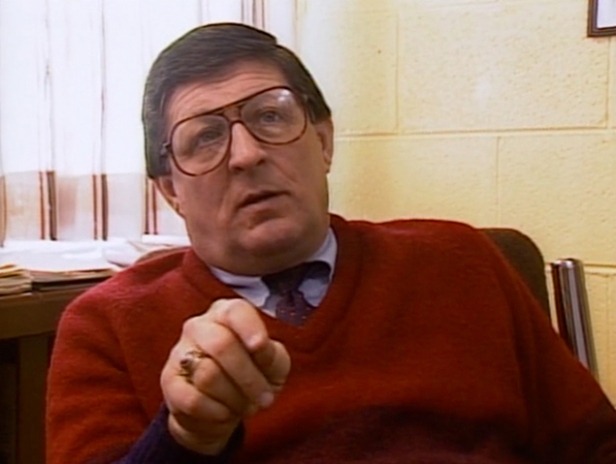At their best, documentaries can give you an insight into a slice of life of which you would otherwise have no knowledge. ‘Hoop Dreams’ goes far beyond just that. It aims to give you a slice of life for two teenage basketball players from inner-city Chicago. And what it shows you is something about life itself.
To put it bluntly, the film is quite frankly astonishing. Hoop Dreams was originally planned to be a 30-minute documentary for PBS filmed over the course of three weeks. But the filmmakers – just as the audience does too – ended up so attached to the individuals and caught up in their stories, that the final project lasted five years, involved shooting more than 250 hours of footage, with the eventual outcome of a three hour theatrically released film. I shall try to keep my description of events in the film to a minimum, because my words cannot do justice to the story told.
Hoop Dreams charts the course of William Gates and Arthur Agee for four years through high school. Both have dreams of becoming professional NBA players, just like local star Isiah Thomas. Their talent and potential means that they are both offered scholarships to St Joseph’s High School, an overwhelmingly white, middle-class suburban school – albeit one with a track record of producing basketball players, such as Thomas himself.

Coming from poor African-American families living in housing projects in central Chicago, the decaying, urban environment that they boys are surrounded by throughout their childhood, is miles away from life for most the children at St Joseph’s. Literally miles away, with William and Arthur making ninety minute commutes daily. While the school does its best to indicate that it is supporting them, it soon becomes clear that the school, rather than care for them as people, only cares for them if they continue to show talent basketball, make their grades, and pay their fees.
The importance of William and Arthur’s academic work grows throughout the film. To have a basketball career, they need to play at college level. And to make it to college – even a basketball-centric one – there are minimum exam results that need to be achieved. Meanwhile, the high school – caring only about the performance of the team – encourage them to focus their time and effort on the sport, to the detriment of their studies. It becomes clear that exams could be as much of a challenge as becoming great sportsmen. The tension of the sports matches is overtaken by that of envelopes arriving with results.
And that is not to take away from the tension of the sporting action. During the games when they are shooting [correct terminology, ed.?], the smallest moments take on a great significance. It becomes far more than just sport, because the audience is fully aware of the material impact that each shot will have on their lives, their careers, and their dreams.

What should be made clear – as it is one of the greatest aspects of the film – is that it is about far more than just William and Arthur. It may start out as their story, but the boys’ friends, families and communities all become significant characters, and each of them has their own story, with their own successes and failures.
There is William’s brother, Curtis Gates. We are introduced to him as an overweight older brother who is unable to keep a job for very long, but is very supportive of William’s efforts to become professional. In many other films or documentaries, his story would be left there. But the film starts to search his past too, and it is revealed that he too had the potential to become professional, and wasted his talent. He is now living out his old dreams through William.
And there is the St Joseph’s coach, a John Goodman look-a-like called Mr Pingatore. He is utterly determined to get each player to be as great as they can. But his harsh teaching methods leave individuals like William and Arthur questioning their love of the game (think of J.K. Simmons’ character in ‘Whiplash’ (Damien Chazelle, 2014)).

And perhaps the most moving sequence in the entire film – and there are a lot from which to choose – is when Arthur’s mother graduates with a nursing qualification. The graduation ceremony is the first time we learn about this part of her life, yet it is evident that to her it is a huge part of her life. The ceremony takes place in a near-empty hall – the number of nurses qualifying just about outnumbers the audience. Yet the joy and happiness for those individuals leaves the audience unable to comprehend how thousands of people can go to high school basketball games each week, yet barely a dozen can go to an event such as this. You ask the question as to why society seems to put so much weight on sport as a place for achievement, and not on accomplishments such as this.
There are more stories of families and community, absent parents and caring parents, growing up, childhood, race, prison, setbacks, dreams and ambitions. The film has evolved far beyond just the story of William and Arthur, and has become a commentary on life.
Whilst the film makes no attempt to manipulate the plot to make it more dramatic, there are moments where the film becomes remarkably poetic. For example, there is one scene where Arthur has to choose a topic to study and on which to write a report. The filmmakers could barely have contained their delight when he chose ‘the lifecycle of the butterfly’.
Or when an older William, travels back to his old grammar school gym just to play by himself, resurrecting memories of his childhood love of the game that had perhaps been driven out of him by John Goodman Mr Pingatore.
The key to the film’s success is that it makes no attempt to be glamorous or ‘showy’, or to direct the audience’s emotion. For example, the voiceover (by Steve James himself), may initially appear monotonous or even disinterested in its subject. But its plain, simple, and purely descriptive style suits the film perfectly, deliberately not exaggerating or over-playing events.
The voiceover is symptomatic of the film as a whole, which never tries to ‘Hollywood-ise’ the events, or deliberately manipulate the audience emotionally with a false dramatic course. Events just take their natural course in life, with ups-and-downs, and downs-and-ups. William and Arthur’s hopes and dreams become ours; we feel their painful moments and celebrate in their successes.
Roger Ebert named Hoop Dreams as the greatest film of the 1990s. And it is difficult to disagree with him. Twenty years later, the director Steve James would make another exceptional documentary, ‘Life Itself’ (2014), about Ebert himself. And in a beautifully circular way, that is why Hoop Dreams is such a remarkable film: because it is about life itself.

Such a great film. It really conveys how an individual’s life circumstances can dramatically alter their life course even when they have the same opportunity at one point in time. It also didn’t feel like three hours when I was watching it because you grow to care so much about the characters.
LikeLiked by 1 person
I completely agree with you. I absolutely loved it. I think it’s probably even the best film I’ve reviewed since starting this blog.
I’ve just had a look at your blog. It looks like we’ve both had the same idea of reviewing (mostly) classic films!
LikeLiked by 1 person
It says a lot that it was Roger Ebert’s favourite film. I love classic film but I don’t want to restrict myself too much in what I can write about, just as long as it’s a great film! I look forward to reading more of your posts as well!
LikeLike